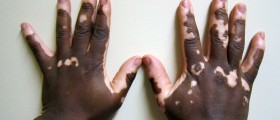
Melanoma is a malignant tumor of melanocytes. Melanocytes are melanin-produced cells located at the lower layer of the skin’s epidermis. Melanin is the pigment, which is responsible for the color of the skin. However, these melanin-producing cells are not only found on skin. They occupy the middle of the eye, the inner ear, the meninges, bones, and the heart. The process of melanin production is known as melanogenesis. Melanogenesis leads to long-lasting tan. Therefore, lighter-skinned people have low basal levels of melanogenesis, but exposure to UV-B radiation causes increased melanogenesis. Melanoma is therefore, most common among Caucasians living in sunny climates. This is the rarest but the most severe type of cancer, with the mortality rate of about 75 percent.
Causes of melanoma
As all other cancers, melanoma is caused by the damage to the DNA inside cells. Sometimes, this damage is inherited form of genetic mutations, but generally, it results from different factors from person’s environment. When DNA damage occurs, the cells start growing out of control, which leads to a tumor. Unlike other types of cancer, melanoma is caused by damage from UV light from sun and sun beds.
Symptoms of melanoma
The earliest sign of melanoma is the change to the shape or color of the existing moles, or the appearance of a new lump anywhere on the skin. Early signs include asymmetry, irregular borders, changes in color, diameter that is greater than 6 millimeters and shape that change over time. The most dangerous type of melanoma is elevated above the surface of the skin, very firm to the touch, and continues to grow.
Prevention of melanoma
The key to prevention of melanoma is to avoid exposure to the sun and sun beds. People with family history of melanoma should pay special attention. To lessen the risk of melanoma, one should always wear protective clothing and protect the skin using sunscreens with an appropriate SPF rating. Sunscreens with avobenzone, zinc, and titanium are especially good, since they can block UVA and UVB even at lower SPF.
However, a part of the medical society argues if the sunscreen has the ability prevent melanoma. This is because people who use sunscreens may prevent burns, but may also have a higher lifetime exposure to hazardous sunrays. This discussion is known under the name sunscreen controversy.
People should avoid any sun exposure between 9 am and 3 pm, or whenever the shadow is shorter than one’s height. If one has to go out, it is important to wear proper clothes: long-sleeved shirts, long trousers, and broad-brimmed hats.

















Your thoughts on this
Loading...